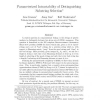Free Online Productivity Tools
i2Speak
i2Symbol
i2OCR
iTex2Img
iWeb2Print
iWeb2Shot
i2Type
iPdf2Split
iPdf2Merge
i2Bopomofo
i2Arabic
i2Style
i2Image
i2PDF
iLatex2Rtf
Sci2ools
MST
2006
2006
Parameterized Intractability of Distinguishing Substring Selection
A central question in computational biology is the design of genetic markers to distinguish between two given sets of (DNA) sequences. This question is formalized as the NP-complete Distinguishing Substring Selection problem (DSSS for short) which asks, given a set of "good" strings and a set of "bad" strings, for a solution string which is, with respect to Hamming metric, "away" from the good strings and "close" to the bad strings. More precisely, given integers dg, db, and L, we ask for a length-L string s such that s has Hamming distance at least dg to every length-L substring of the good strings and such that every bad string has a length-L substring with Hamming distance at most db to s. Studying the parameterized complexity of DSSS, we show that, already for binary alphabet, DSSS is W[1]-hard with respect to its natural parameters. This, in particular, implies that a recently given polynomial-time approximation scheme (PTAS) by Deng et al....
| Added | 14 Dec 2010 |
| Updated | 14 Dec 2010 |
| Type | Journal |
| Year | 2006 |
| Where | MST |
| Authors | Jens Gramm, Jiong Guo, Rolf Niedermeier |
Comments (0)

